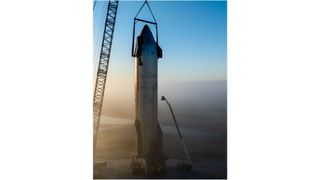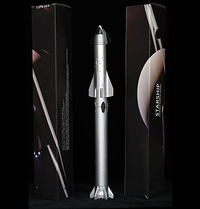
Just a week after Starship's third test flight, SpaceX is already gearing up for the next one.
The 400-foot-tall (122 meters) Starship, the biggest and most powerful rocket ever built, flew for the third time ever on March 14.
The fully reusable two-stage vehicle notched some significant milestones on the test mission, which launched from SpaceX's Starbase site in South Texas. For example, its 165-foot-tall (50 m) upper stage, known as Starship or just Ship, achieved orbital velocity and stayed aloft for about 50 minutes before breaking apart during its reentry to Earth's atmosphere.
And the megarocket's first stage, a giant booster called Super Heavy, aced its boostback burn. Super Heavy did not splash down in the Gulf of Mexico as planned, however; it broke apart about 1,650 feet (500 m) above the waves.
Related: Relive SpaceX Starship's 3rd flight test in breathtaking photos

SpaceX is still analyzing data from last week's flight, but it's also looking ahead to mission number four. Indeed, the company has moved the coming flight's Ship out to the launch pad at Starbase "for upcoming static fires," SpaceX said in a post on X on Friday afternoon (March 22).
Static fires are coming prelaunch tests, in which engines are fired briefly while a vehicle is anchored to the launch pad. If the impending static fires and other trials go well — and if the Federal Aviation Administration grants a launch license in time — Starship could fly again as soon as early May, SpaceX President and Chief Operating Officer Gwynne Shotwell said earlier this week.
Get the Space.com Newsletter
Breaking space news, the latest updates on rocket launches, skywatching events and more!
SpaceX's Friday X post shared a photo of the recently moved Ship, as well as a second image showing three Ships partially shrouded by heavy fog at Starbase. As that second shot suggests, SpaceX plans to conduct a number of Starship test flights this year — six or more, if all goes according to plan, according to company founder and CEO Elon Musk.
Starship Die Cast Rocket Model Now $69.99 on Amazon.
If you can't see SpaceX's Starship in person, you can score a model of your own. Standing at 13.77 inches (35 cm), this is a 1:375 ratio of SpaceX's Starship as a desktop model. The materials here are alloy steel and it weighs just 225g.
Note: Stock is low so you'll have to act quickly to get this.
SpaceX is developing Starship to get people and cargo to the moon and Mars, as well as to perform a variety of other spaceflight tasks.
NASA has a keen interest in the megarocket's progress; the space agency picked Starship as the first crewed lunar lander for its Artemis moon program. The current schedule calls for Starship to put NASA astronauts down on the moon for the first time in September 2026, on the Artemis 3 mission.
Join our Space Forums to keep talking space on the latest missions, night sky and more! And if you have a news tip, correction or comment, let us know at: community@space.com.

Michael Wall is a Senior Space Writer with Space.com and joined the team in 2010. He primarily covers exoplanets, spaceflight and military space, but has been known to dabble in the space art beat. His book about the search for alien life, "Out There," was published on Nov. 13, 2018. Before becoming a science writer, Michael worked as a herpetologist and wildlife biologist. He has a Ph.D. in evolutionary biology from the University of Sydney, Australia, a bachelor's degree from the University of Arizona, and a graduate certificate in science writing from the University of California, Santa Cruz. To find out what his latest project is, you can follow Michael on Twitter.










